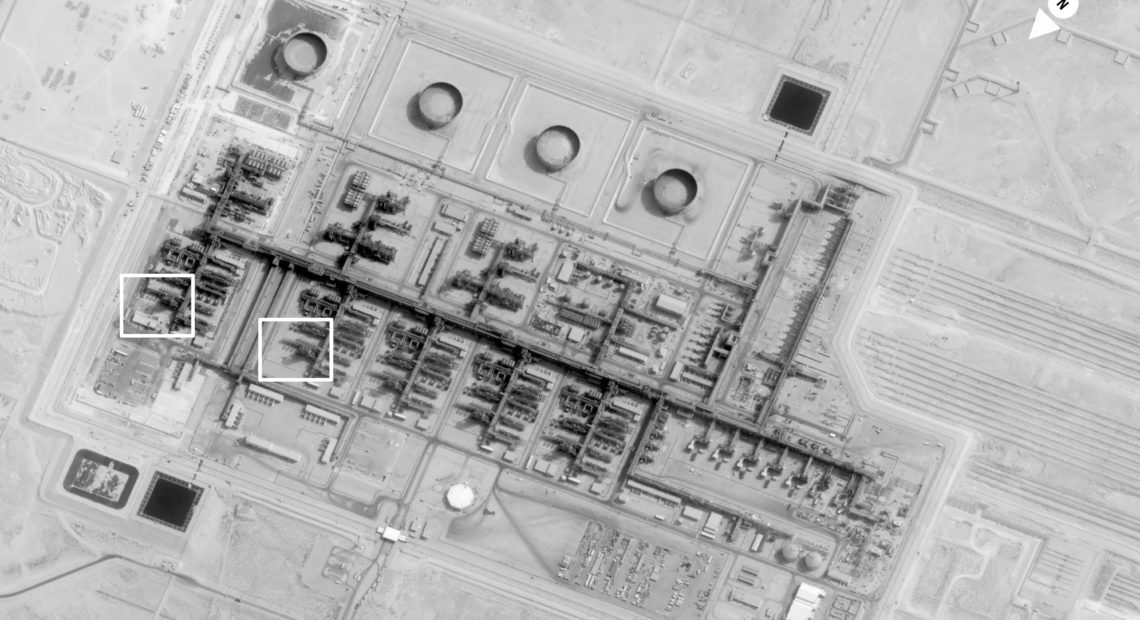
Oil Prices Jump Following Drone Attack On Saudi Oil Facilities
PHOTO: This image provided on Sunday by the U.S. government and DigitalGlobe and annotated by the source, shows a prestrike overview at Saudi Aramco’s Khurais oil field in Buqayq, Saudi Arabia. CREDIT: U.S. government/Digital Globe via AP
BY SCOTT NEUMAN & BILL CHAPPELL
The price of oil saw a massive price spike Monday following drone strikes on a Saudi oil facility over the weekend that has shut off more than half of the kingdom’s daily exports, or about 5% of the world’s crude production.
Benchmark Brent crude briefly surged almost 20% in early trading before settling to 10% higher, up $6 to $66.28 per barrel, according to The Associated Press. The U.S. benchmark West Texas crude was up 9%.
The increase, which follows drone attacks on Saudi Arabia’s Abqaiq oil processing plant and Khurais oil field, marks the single-largest daily surge in crude prices in years.
The loss of the 5.7 million barrels of Saudi crude production represents the largest such disruption on record, according to figures from the Paris-based International Energy Agency.
Experts say it could take weeks before the kingdom is able to restore full production at the facilities, according to The Telegraph.
Riyadh says its stockpiles will keep world markets supplied until it can repair the damage at Abqaiq and Khurais.
The attacks come as Saudi Arabia prepares to sell stock in its state-owned oil giant Saudi Aramco, in what’s predicted to be the largest IPO in history. While only a small percentage of the company is expected to be sold, Aramco is currently valued at anywhere from $1.5 trillion to $2 trillion.
The IPO would have two phases: a local sale in Saudi Arabia that’s expected to occur late this year, and an international sale that would happen in 2020.
With some of Aramco’s largest oil facilities now out of commission, Saudi officials are now considering delaying the company’s IPO, according to The Wall Street Journal.
Yemen’s Iranian-backed Houthi rebels have claimed responsibility for the attacks, and Iran has denied involvement. But U.S. officials are blaming Iran.
On Monday, President Trump implied Iran’s denials were false, mentioning the country’s recent downing of a U.S. drone and ending a tweet by asking, “We’ll see?”
That remark follows Trump’s comments from Sunday evening, when he said, “There is reason to believe that we know the culprit, are locked and loaded depending on verification, but are waiting to hear from the Kingdom as to who they believe was the cause of this attack, and under what terms we would proceed!”
Although Saudi officials have been cautious about laying blame, Secretary of State Mike Pompeo has directly accused Tehran of playing a key role in the strikes.
“Amid all the calls for de-escalation, Iran has now launched an unprecedented attack on the world’s energy supply. There is no evidence the attacks came from Yemen,” Pompeo tweeted Saturday.
Tehran is behind nearly 100 attacks on Saudi Arabia while Rouhani and Zarif pretend to engage in diplomacy. Amid all the calls for de-escalation, Iran has now launched an unprecedented attack on the world’s energy supply. There is no evidence the attacks came from Yemen.
— Secretary Pompeo (@SecPompeo) September 14, 2019
Iran’s Foreign Ministry spokesman Abbas Mousavi dismissed Washington’s accusations, calling them “blind and futile.”
“The Americans adopted the ‘maximum pressure’ policy against Iran, which, due to its failure, is leaning toward ‘maximum lies,’ ” Mousavi said.
Faced with a possible disruption to the U.S. energy supply, Trump said Sunday that he has authorized the release of oil from the U.S. Strategic Petroleum Reserve if necessary “in a to-be-determined amount … sufficient to keep the markets well-supplied.”
In his remarks about Iran and the attacks in Saudi Arabia, Trump is using similar language to his earlier comments toward Tehran in June, after a U.S. drone was shot down over what Washington says were international waters.
Trump’s latest tweets followed a National Security Council meeting at the White House that included Pompeo, Vice President Pence and Defense Secretary Mark Esper, the AP reported.















